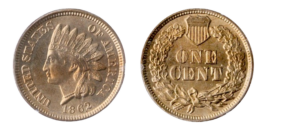1862 Indian Head Cent: James Longacre’s Civil War Masterpiece
Posted onJames B. Longacre, Chief Engraver of the U.S. Mint, is best remembered today for his creation of the iconic Indian Head cent.
The 1862 Indian Head cent was struck during a pivotal phase of the Civil War, which saw a shift in momentum and strategic gains for the Union Army. Major battles included the Battle of Shiloh in Tennessee, the Union capture of New Orleans, and the Seven Days Battles outside Richmond. The bloody Battle of Antietam in September 1862 had no clear winner. But this significant Civil War battle opened the door for President Lincoln to announce the Preliminary Emancipation Proclamation.
Indian Head cents are a classic early American coin coveted by collectors due to their design, historical significance, and rarity. Minted from 1859 through 1909, Indian Head cents were produced in large numbers in most years.
In 1862, against the backdrop of a war-torn nation, the Philadelphia Mint produced 28,075,000 Indian Head cents. The production met huge demand for small change in the cash-starved economy. Amid the chaos of wartime, citizens were hoarding precious metals.
While the 1862 cents’ mintage was substantial, survival rates tell a different story. Most coins circulated heavily, leaving few in pristine condition.
Today, a mere 400 survivors are estimated in grades 65 or better.
In 1909, the Indian Head cent was replaced by the Lincoln cent, designed by Victor D. Brenner, closing this important era in U.S. numismatic history.
Longacre’s vivid design features a representation of Liberty wearing an Indian headdress, blending classic artistry with frontier imagery. The obverse includes the word “LIBERTY” on the Native American headdress, encircled by “UNITED STATES OF AMERICA” and the date “1862″ at the bottom.
The reverse features an intricately beautiful oak wreath encircling the coin’s denomination “ONE CENT.” A small shield sits at the top, symbolizing victory. The 1862 Indian Heads are known for being usually well-struck and with excellent luster. The 1862 Indian Cent was struck with an alloy of 88% copper and 12% nickel, creating the coin’s pale hue. It clocks in with a substantial weight at 4.67 grams.
Today, collectors interested in Civil War history and early American coinage jump at the opportunity to own an Indian Head cent, a tangible piece of early American history. Whether you desire to acquire a coin like this as a standalone treasure or part of a larger collection, this rarity is a testament to the enduring legacy of early American coinage. Blanchard has one of these magnificent coins on offer now. See it here.
Read more
Copper Shortage Paves Way for Small Flying Eagle Cent
Top 5 Rare Coins You Should Collect
Want to read more? Subscribe to the Blanchard Newsletter and get our tales from the vault, our favorite stories from around the world and the latest tangible assets news delivered to your inbox weekly.







